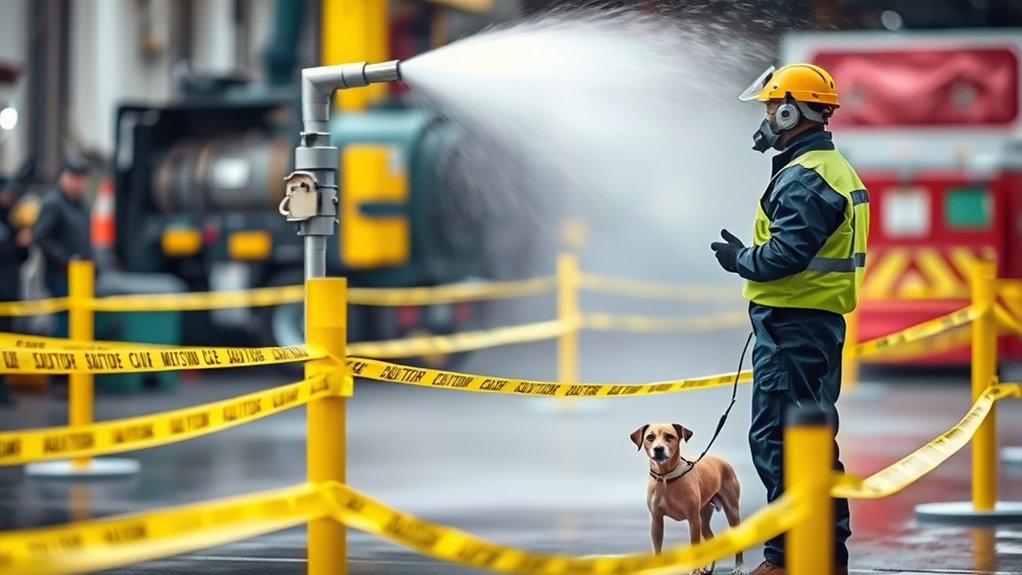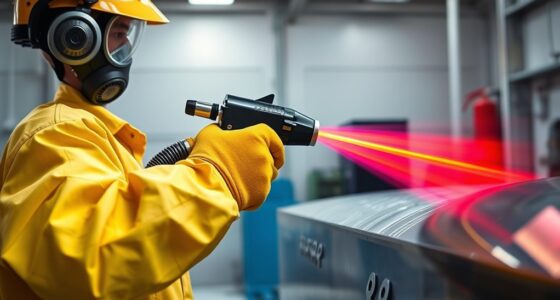To keep bystanders and pets safely away from the spray zone, set up clear safety barriers like fences or cones, making sure they are visible from a distance. Place warning signs at strategic points to alert people of the dangers. Use verbal warnings and communicate effectively before starting operations. Consider environmental factors like wind direction to prevent spray drift. For more detailed safety tips, continue exploring how to guarantee everyone’s protection during spraying procedures.
Key Takeaways
- Install physical safety barriers like fencing or cones around the spray zone to restrict access.
- Place clear, visible warning signs at all entry points and around the perimeter.
- Position barriers considering wind direction to prevent spray drift toward bystanders and pets.
- Use verbal warnings and communication to inform nearby people about ongoing spray activities.
- Regularly maintain barriers and signs to ensure visibility and effectiveness throughout the operation.

When working with spray zones, it’s important to keep bystanders and pets at a safe distance to prevent accidents or exposure to harmful substances. This isn’t just about common sense; it’s about implementing effective safety measures that keep everyone protected. Installing safety barriers is one of the most straightforward and reliable ways to create a physical boundary around the spray zone. These barriers, whether temporary fencing or cones, serve as a clear visual cue that the area is off-limits. They help prevent accidental entry by curious pets or unaware passersby, reducing the risk of exposure to chemicals or equipment mishaps.
Safety barriers effectively prevent accidental entry and protect pets and bystanders during spray zone operations.
Alongside safety barriers, warning signs play a key role in alerting people to the potential dangers within the spray zone. Strategically placing clear, visible signs around the perimeter makes it obvious that spraying is underway and that entry is restricted. Use signs that are easy to read and include icons or symbols for quick recognition, especially for those who may not speak the language fluently. Proper signage not only informs but also acts as a deterrent, discouraging people from crossing into the danger zone. Remember, signs should be placed at eye level and at all access points to maximize visibility.
You should also consider the placement of safety barriers and warning signs in relation to the wind direction and surrounding environment. For example, if the wind blows toward a public walkway or residential area, additional barriers or signs may be needed further away from the spray zone to account for spray drift or airborne particles. This extra precaution helps protect bystanders who might not realize they’re at risk until it’s too late. Furthermore, ensure that all safety barriers and warning signs are maintained and visible throughout the spraying process. Damaged or obscured signs can easily be ignored or missed, increasing the chance of accidental exposure.
Additionally, understanding the expiration of substances used and monitoring environmental conditions can help prevent unintended exposure or contamination. Lastly, communicate clearly with anyone nearby before starting the spray process. Use verbal warnings along with your safety barriers and signs to make sure everyone understands the potential risks and the importance of staying clear. By combining physical barriers, effective signage, and clear communication, you create a thorough safety system that minimizes risks. Keeping bystanders and pets at a safe distance isn’t just about following regulations; it’s about actively preventing accidents and protecting health. Properly implemented safety barriers and warning signs are your best tools to guarantee that everyone remains safe and informed during spray zone operations.
Frequently Asked Questions
What Are the Best Signs to Warn Passersby?
You should use clear visual warning signs that catch attention and clearly state “Keep Out” or “Danger: Spray Zone” to inform passersby. Combine these signs with physical barricades like cones or tape to create a strong barrier. This combination effectively alerts everyone to stay away, ensuring safety. Make sure signs are visible from a distance and placed at all entry points to prevent accidental entry into the spray zone.
How Can I Quickly Contain Pets During Spraying?
You can quickly contain pets during spraying by using portable barriers like pet gates or makeshift barriers such as overturned laundry baskets. If you lack these, grab nearby objects like furniture or boxes to create a temporary enclosure. While some might think pets will escape, immediate pet containment minimizes their risk of exposure. Act fast, and guarantee the barriers are secure so your pets stay safe and away from the spray zone.
Are There Specific Barriers That Work Best?
You should use barriers that are highly effective and visible, like sturdy, brightly colored fencing or portable screen panels. These barriers are designed for maximum barrier effectiveness, preventing pets and bystanders from entering the spray zone. Make sure signs are clearly visible, indicating the restricted area and potential hazards. Combining physical barriers with clear signage guarantees safety and minimizes accidental entry, keeping everyone and pets safe during spraying operations.
How Long Should I Keep the Area Restricted?
You should keep the spray zone limited for at least 30 minutes after spraying, or until the area is completely dry. This restricted duration ensures that the chemicals have enough time to settle and reduces risk of exposure to bystanders and pets. Always monitor the area and remove any barriers once you’re confident the residue has dried, preventing accidental contact and ensuring safety for everyone involved.
What Should I Do if Someone Enters the Spray Zone?
Studies show that 80% of pesticide exposure incidents occur when someone enters the spray zone unknowingly. If someone enters, follow your evacuation procedures immediately and alert them to leave the area. Use warning protocols like signs or alarms to prevent further entry. Make certain everyone understands the importance of staying clear during spraying, and document the incident to improve safety measures and prevent future risks.
Conclusion
To keep everyone safe, always guarantee bystanders and pets stay clear of the spray zone. It might seem like a hassle, but it’s worth it to prevent accidents or exposure to harmful chemicals. No one wants a pet or a neighbor accidentally affected. By taking a few extra seconds to cordon off the area, you protect everyone and make the process smoother. Remember, safety comes first—your effort keeps everyone secure and stress-free.










